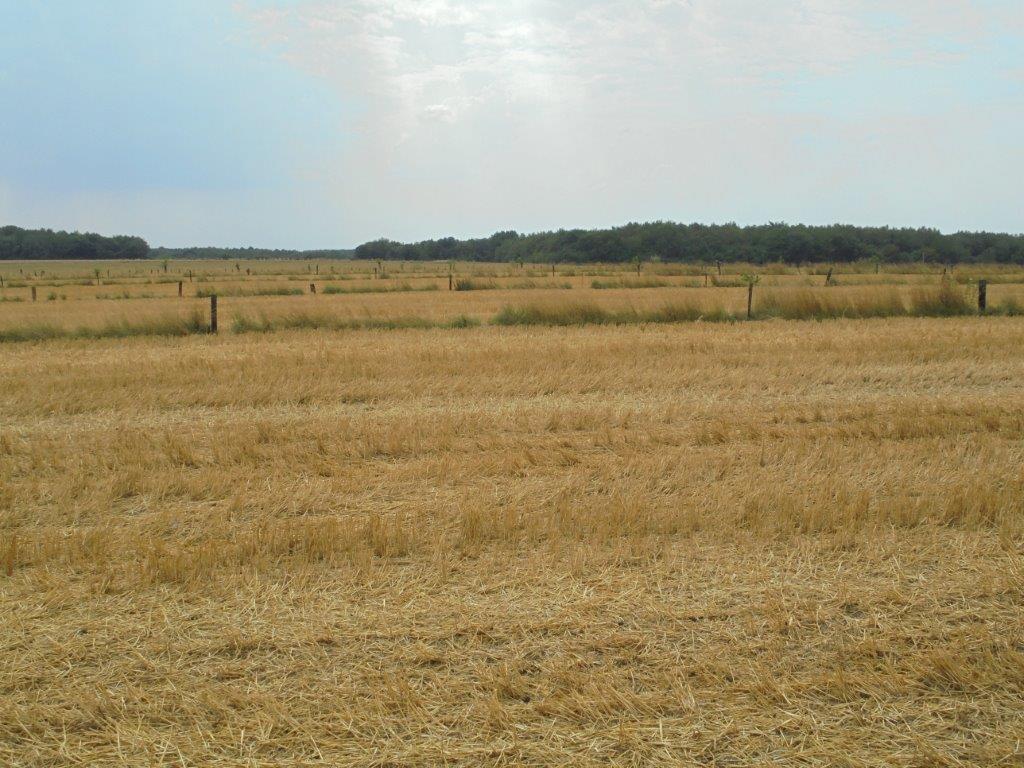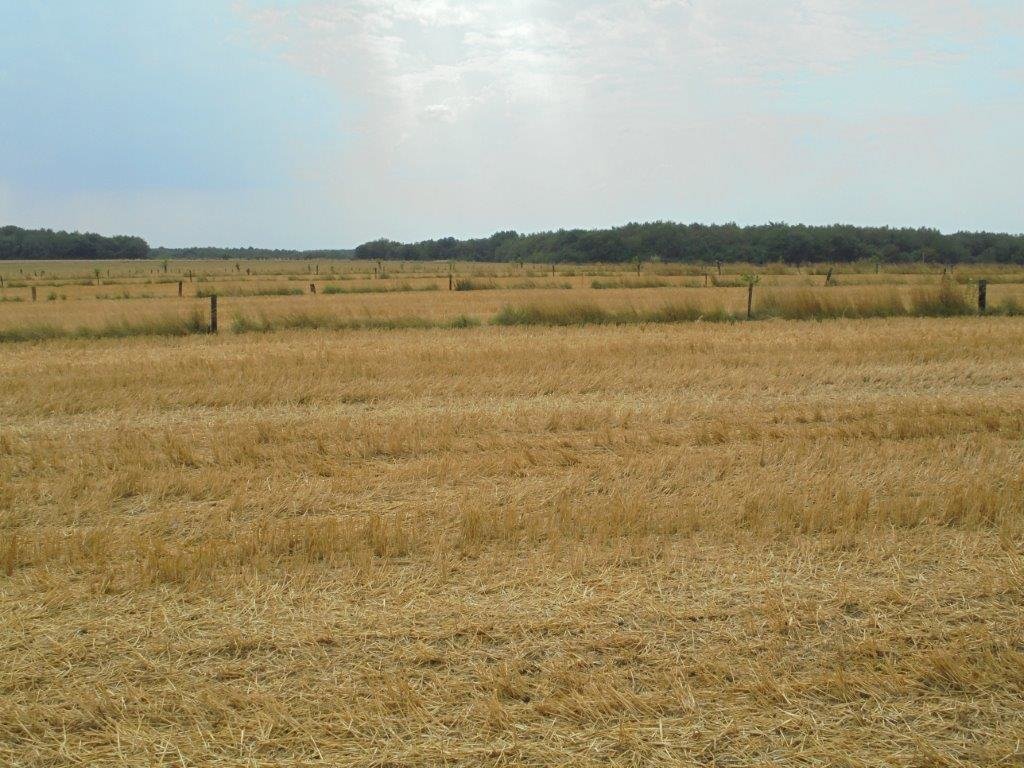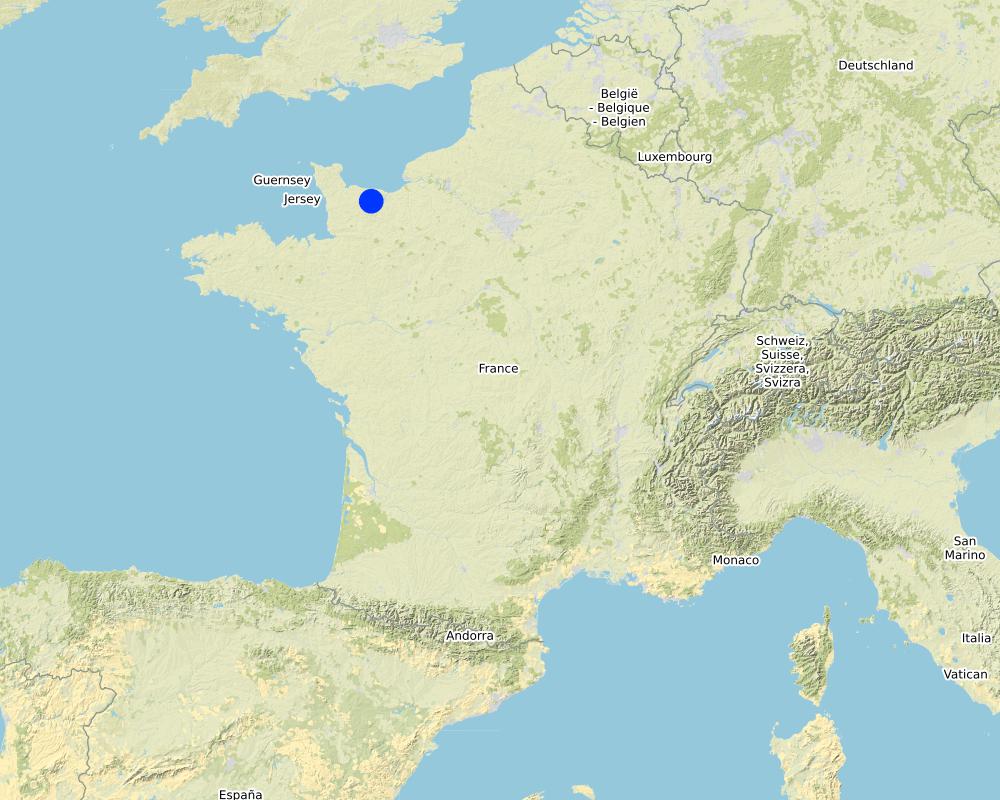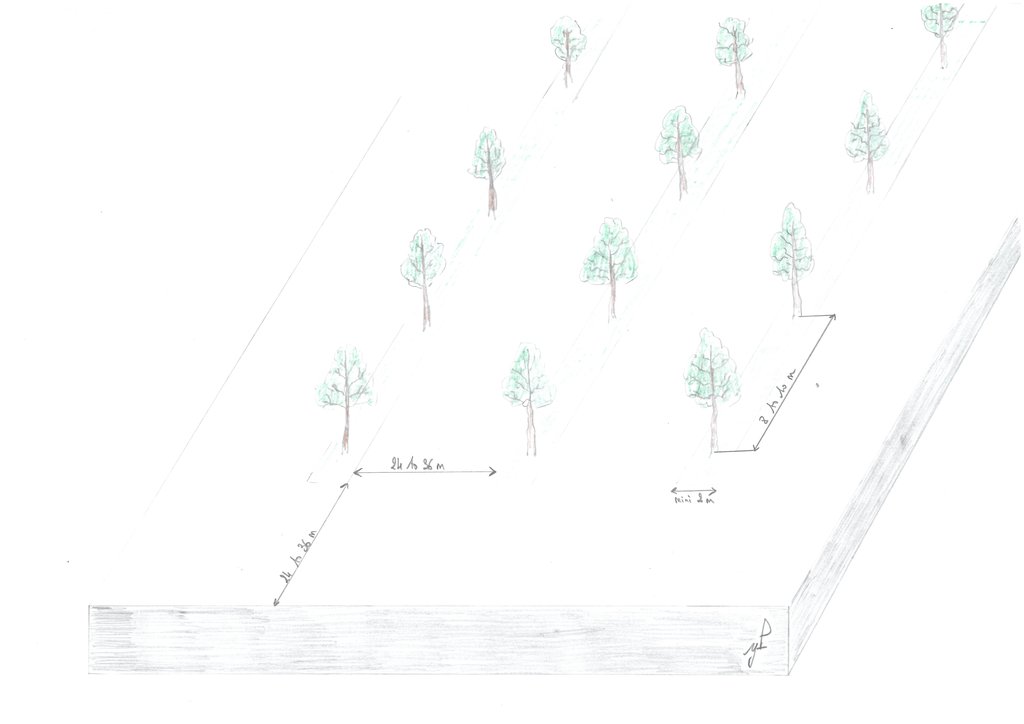Alley cropping - Agroforestry [France]
- Creation:
- Update:
- Compiler: Alan Radbourne
- Editors: David Norris, Sabine Reinsch
- Reviewers: Rima Mekdaschi Studer, William Critchley
agroforesterie intra parcellaire
technologies_5645 - France
View sections
Expand all Collapse all1. General information
1.2 Contact details of resource persons and institutions involved in the assessment and documentation of the Technology
Key resource person(s)
SLM specialist:
Pivain Yann
Chambre d’agriculture de Normandie
France
SLM specialist:
Galmel Michel
Ferme des Ruelles
France
Name of project which facilitated the documentation/ evaluation of the Technology (if relevant)
European Interreg project FABulous FarmersName of the institution(s) which facilitated the documentation/ evaluation of the Technology (if relevant)
UK Centre for Ecology & Hydrology (CEH) - United KingdomName of the institution(s) which facilitated the documentation/ evaluation of the Technology (if relevant)
Association des Chambres d’agriculture de l’Arc Atlantique (AC3A) - France1.3 Conditions regarding the use of data documented through WOCAT
The compiler and key resource person(s) accept the conditions regarding the use of data documented through WOCAT:
Yes
1.4 Declaration on sustainability of the described Technology
Is the Technology described here problematic with regard to land degradation, so that it cannot be declared a sustainable land management technology?
No
2. Description of the SLM Technology
2.1 Short description of the Technology
Definition of the Technology:
The implementation of agroforestry in a cereal field can help aid biodiversity, that will in turn support natural pest control, improve the resilience to water and climate stress through improved infiltration, provide more shade and less wind-stress, and will improve soil health, among other benefits.
2.2 Detailed description of the Technology
Description:
Agroforestry, that is the incorporation of trees into agriculture, is a traditional land management practice in Normandy using apple trees inter-grazed by cows on pasture. However, between 1960 and 2000, the restructuring of agricultural land, and technical and technological developments, have led to the disappearance of agroforestry in Normandy. Since the beginning of the 21 century, the integration of trees into the system has started to be reintroduced, not only in grassland systems, but also in crop fields.
The integration of trees into the system is effective for countering:
- Biological degradation: by enhancing biodiversity though improved refuge for insects and birds, providing food for them, breeding opportunities and connectivity corridors across the landscape. This leads to greater biological regulation of crop pests among other benefits.
- Climate related stress: both at the local level (decrease of wind speeds, reduction of evapotranspiration, shade for animals) and at the global level (carbon storage, substitution of fossil energies by renewable energy).
- Water degradation: through the qualitative and quantitative regulation of water at the watershed scale as a benefit of improved rainfall infiltration and less fertilizer lost in runoff.
- Soil erosion by water and chemical deterioration: through the conservation of soils with reduced runoff.
- Soil erosion by wind: through the protection of exposed areas.
and:
- Providing benefits through beautification of the living environment.
As part of the agroforestry SLM technology, trees are planted on grassed strips which are 24 to 30 m apart within the field of cereals. Trees are spaced 8 to 10 m within the strips. This configuration has been adapted to allow mechanized agriculture. The main tree species used are Quercus, Sorbus, Tilia, Prunus and Robinia. Land users, with some support from the local community, financed the re-introduction of agroforestry into Normandy. Soil was prepared using machinery (single line ploughing), mulch was applied and tree seedlings were protected against wild animals.
Despite these financial and management benefits. the SLM technology has not yet been taken up widely. Therefore, the aim is to promote better adoption of agroforestry practices by Normandy farmers. This is becoming more important as the use of external inputs (e.g. fertilizers and pesticides) is increasingly expensive for both farmers and society - and the introduction of agroforestry can both help reduce these costs with more natural pest control and less runoff of fertilisers from the fields.
The compilation of this SLM is a part of the European Interreg project FABulous Farmers which aims to reduce the reliance on external inputs by encouraging the use of methods and interventions that increase the farm’s Functional AgroBiodiversity (FAB). Visit www.fabulousfarmers.eu and www.nweurope.eu/Fabulous-Farmers for more information.
2.3 Photos of the Technology
2.5 Country/ region/ locations where the Technology has been applied and which are covered by this assessment
Country:
France
Region/ State/ Province:
Normandy
Specify the spread of the Technology:
- applied at specific points/ concentrated on a small area
Is/are the technology site(s) located in a permanently protected area?
No
Comments:
(note map represents region of Normandy not precise location of technology due to protection of GDPR location data)
Map
×2.6 Date of implementation
Indicate year of implementation:
2017
If precise year is not known, indicate approximate date:
- less than 10 years ago (recently)
2.7 Introduction of the Technology
Specify how the Technology was introduced:
- through land users' innovation
- through projects/ external interventions
Comments (type of project, etc.):
Farmer innovation and interest has been linked to projects encouraging the uptake of functional agrobiodiversity measures; the project in this case is the EU Interreg Fabulous Farmers project.
3. Classification of the SLM Technology
3.1 Main purpose(s) of the Technology
- improve production
- reduce, prevent, restore land degradation
- preserve/ improve biodiversity
- adapt to climate change/ extremes and its impacts
- create beneficial economic impact
3.2 Current land use type(s) where the Technology is applied
Land use mixed within the same land unit:
Yes
Specify mixed land use (crops/ grazing/ trees):
- Agroforestry

Cropland
- Annual cropping
Annual cropping - Specify crops:
- cereals - barley
- cereals - maize
- Several species over the years, varies by farm
Number of growing seasons per year:
- 1
Is intercropping practiced?
No
Is crop rotation practiced?
Yes
If yes, specify:
Primarily rotation of cereal crops on an annual basis.
3.3 Has land use changed due to the implementation of the Technology?
Has land use changed due to the implementation of the Technology?
- No (Continue with question 3.4)
Land use mixed within the same land unit:
Yes
Specify mixed land use (crops/ grazing/ trees):
- Agroforestry
3.4 Water supply
Water supply for the land on which the Technology is applied:
- rainfed
3.5 SLM group to which the Technology belongs
- agroforestry
- windbreak/ shelterbelt
- integrated pest and disease management (incl. organic agriculture)
3.6 SLM measures comprising the Technology

agronomic measures
- A2: Organic matter/ soil fertility

vegetative measures
- V1: Tree and shrub cover

management measures
- M1: Change of land use type
3.7 Main types of land degradation addressed by the Technology

soil erosion by water
- Wt: loss of topsoil/ surface erosion
- Wg: gully erosion/ gullying

soil erosion by wind
- Et: loss of topsoil

chemical soil deterioration
- Cn: fertility decline and reduced organic matter content (not caused by erosion)

biological degradation
- Bh: loss of habitats
- Bs: quality and species composition/ diversity decline
- Bp: increase of pests/ diseases, loss of predators
3.8 Prevention, reduction, or restoration of land degradation
Specify the goal of the Technology with regard to land degradation:
- prevent land degradation
- reduce land degradation
4. Technical specifications, implementation activities, inputs, and costs
4.1 Technical drawing of the Technology
Technical specifications (related to technical drawing):
The agroforestry trees are planted on grassed strips of at least 2 m width, 24 to 36 m apart, in a 17 ha field of cereals.
The trees are spaced 8 to 10 m apart.
The configuration is adapted to mechanised agriculture.
The main species used: Quercus, Sorbus, Tilia, Prunus and Robinia. Any dead trees are replaced in the first 3 years.
Author:
Yann Pivain
Date:
01/11/2019
4.2 General information regarding the calculation of inputs and costs
Specify how costs and inputs were calculated:
- per Technology area
Indicate size and area unit:
1 ha
If using a local area unit, indicate conversion factor to one hectare (e.g. 1 ha = 2.47 acres): 1 ha =:
1ha = 2.47 acres
other/ national currency (specify):
€
If relevant, indicate exchange rate from USD to local currency (e.g. 1 USD = 79.9 Brazilian Real): 1 USD =:
0.9
Indicate average wage cost of hired labour per day:
120
4.3 Establishment activities
| Activity | Timing (season) | |
|---|---|---|
| 1. | Choice of the planting site, the design/layout and the species | Spring |
| 2. | Soil preparation (clearing of land, harrowing) | After harvest of crops |
| 3. | Application of mulch to planting strips | After harvest of crops |
| 4. | Tree whips planted in plough slot (approx. 10cm deep), protection spirals fitted and area recovered with mulch | From Nov to Jan |
4.4 Costs and inputs needed for establishment
| Specify input | Unit | Quantity | Costs per Unit | Total costs per input | % of costs borne by land users | |
|---|---|---|---|---|---|---|
| Labour | Design & layout of planting | days | 0.5 | 120.0 | 60.0 | 100.0 |
| Labour | Surface preparation (clearing & harowing) | days | 0.1 | 120.0 | 12.0 | 100.0 |
| Labour | Mulch application | days | 0.2 | 120.0 | 24.0 | 100.0 |
| Labour | Planting | days | 0.5 | 120.0 | 60.0 | 100.0 |
| Equipment | Tractor with harow & Plough | days | 0.3 | 50.0 | 15.0 | 100.0 |
| Plant material | Tree whips | piece/ha | 30.0 | 3.0 | 90.0 | 20.0 |
| Plant material | Mulch | piece/ha | 30.0 | 2.0 | 60.0 | 20.0 |
| Construction material | Base spiral protection | piece/ha | 30.0 | 2.0 | 60.0 | 20.0 |
| Total costs for establishment of the Technology | 381.0 | |||||
| Total costs for establishment of the Technology in USD | 423.33 | |||||
If land user bore less than 100% of costs, indicate who covered the remaining costs:
Local community and grant funding
4.5 Maintenance/ recurrent activities
| Activity | Timing/ frequency | |
|---|---|---|
| 1. | Tree maintenance (pruning by hand as required) | from Jun to Dec all year around |
| 2. | Grass strip mowing (using tractor) | after crop harvest |
4.6 Costs and inputs needed for maintenance/ recurrent activities (per year)
| Specify input | Unit | Quantity | Costs per Unit | Total costs per input | % of costs borne by land users | |
|---|---|---|---|---|---|---|
| Labour | Tree pruning | days | 2.0 | 120.0 | 240.0 | 100.0 |
| Labour | Grass mowing | days | 1.0 | 120.0 | 120.0 | 100.0 |
| Equipment | Tractor & mower | days | 1.0 | 50.0 | 50.0 | 100.0 |
| Total costs for maintenance of the Technology | 410.0 | |||||
| Total costs for maintenance of the Technology in USD | 455.56 | |||||
4.7 Most important factors affecting the costs
Describe the most determinate factors affecting the costs:
Time necessary for maintenance.
Good training to do quality work.
5. Natural and human environment
5.1 Climate
Annual rainfall
- < 250 mm
- 251-500 mm
- 501-750 mm
- 751-1,000 mm
- 1,001-1,500 mm
- 1,501-2,000 mm
- 2,001-3,000 mm
- 3,001-4,000 mm
- > 4,000 mm
Specify average annual rainfall (if known), in mm:
650.00
Specifications/ comments on rainfall:
No dry season or marked rainy season. Rain falls fairly regularily.
Indicate the name of the reference meteorological station considered:
Les Andelys
Agro-climatic zone
- sub-humid
5.2 Topography
Slopes on average:
- flat (0-2%)
- gentle (3-5%)
- moderate (6-10%)
- rolling (11-15%)
- hilly (16-30%)
- steep (31-60%)
- very steep (>60%)
Landforms:
- plateau/plains
- ridges
- mountain slopes
- hill slopes
- footslopes
- valley floors
Altitudinal zone:
- 0-100 m a.s.l.
- 101-500 m a.s.l.
- 501-1,000 m a.s.l.
- 1,001-1,500 m a.s.l.
- 1,501-2,000 m a.s.l.
- 2,001-2,500 m a.s.l.
- 2,501-3,000 m a.s.l.
- 3,001-4,000 m a.s.l.
- > 4,000 m a.s.l.
Indicate if the Technology is specifically applied in:
- not relevant
5.3 Soils
Soil depth on average:
- very shallow (0-20 cm)
- shallow (21-50 cm)
- moderately deep (51-80 cm)
- deep (81-120 cm)
- very deep (> 120 cm)
Soil texture (topsoil):
- medium (loamy, silty)
- fine/ heavy (clay)
Soil texture (> 20 cm below surface):
- fine/ heavy (clay)
Topsoil organic matter:
- medium (1-3%)
5.4 Water availability and quality
Ground water table:
> 50 m
Availability of surface water:
good
Water quality (untreated):
poor drinking water (treatment required)
Water quality refers to:
both ground and surface water
Is water salinity a problem?
No
Is flooding of the area occurring?
Yes
Regularity:
episodically
5.5 Biodiversity
Species diversity:
- medium
Habitat diversity:
- high
Comments and further specifications on biodiversity:
Technology has supported the continued high biodiversity in the region, limiting any possible decline with changing farming practice.
5.6 Characteristics of land users applying the Technology
Sedentary or nomadic:
- Sedentary
Market orientation of production system:
- commercial/ market
Off-farm income:
- 10-50% of all income
Relative level of wealth:
- rich
Individuals or groups:
- individual/ household
Level of mechanization:
- mechanized/ motorized
Gender:
- men
Age of land users:
- middle-aged
5.7 Average area of land used by land users applying the Technology
- < 0.5 ha
- 0.5-1 ha
- 1-2 ha
- 2-5 ha
- 5-15 ha
- 15-50 ha
- 50-100 ha
- 100-500 ha
- 500-1,000 ha
- 1,000-10,000 ha
- > 10,000 ha
Is this considered small-, medium- or large-scale (referring to local context)?
- small-scale
5.8 Land ownership, land use rights, and water use rights
Land ownership:
- individual, not titled
Land use rights:
- individual
Water use rights:
- communal (organized)
Are land use rights based on a traditional legal system?
No
5.9 Access to services and infrastructure
health:
- poor
- moderate
- good
education:
- poor
- moderate
- good
technical assistance:
- poor
- moderate
- good
employment (e.g. off-farm):
- poor
- moderate
- good
markets:
- poor
- moderate
- good
energy:
- poor
- moderate
- good
roads and transport:
- poor
- moderate
- good
drinking water and sanitation:
- poor
- moderate
- good
financial services:
- poor
- moderate
- good
6. Impacts and concluding statements
6.1 On-site impacts the Technology has shown
Socio-economic impacts
Production
crop production
Comments/ specify:
Less land available for cropping
crop quality
Comments/ specify:
No change seen
wood production
Comments/ specify:
Wood produce now integrated
product diversity
Comments/ specify:
Wood product added
land management
Comments/ specify:
Tree lines set for as much ease of mechanical use as possible, yet still does disrupt ease of crop management
Income and costs
farm income
Comments/ specify:
Loss of crop area, yet some less inputs required (i.e. pesticide)
diversity of income sources
Comments/ specify:
Wood and cereal crop combined
workload
Comments/ specify:
Tree maintenence takes longer than when working a single crop field
Socio-cultural impacts
SLM/ land degradation knowledge
Comments/ specify:
Improved skill set with learning & training in agroforestry
Ecological impacts
Water cycle/ runoff
water quality
Comments/ specify:
Trees act as buffer strips for better quality water with less run-off
surface runoff
Comments/ specify:
Trees act as buffer strips for better quality water with less run-off
excess water drainage
Comments/ specify:
Improved soil infiltration
Soil
soil moisture
Comments/ specify:
Improved soil infiltration and moisture capacity
soil loss
Comments/ specify:
Trees act as buffer strips for better quality soil with less run-off erosion
soil accumulation
Comments/ specify:
Trees act as buffer strips for better quality soil with less run-off erosion for bette accumlation
soil compaction
Comments/ specify:
Stips of trees require less passes of tractor in field
nutrient cycling/ recharge
Comments/ specify:
Trees can use deeper nutrient stores
soil organic matter/ below ground C
Comments/ specify:
Increased carbon below ground with larger tree rooting systems
Biodiversity: vegetation, animals
Vegetation cover
Comments/ specify:
Diversity of vegetation between tree grass strips
biomass/ above ground C
Comments/ specify:
Trees hold more above ground C
plant diversity
Comments/ specify:
With trees and diversity of vegetation between tree grass strips
beneficial species
Comments/ specify:
Natural pest control through habitat for predators with trees
habitat diversity
Comments/ specify:
More space for habitat
pest/ disease control
Comments/ specify:
Natural pest control through habitat for predators with trees
Climate and disaster risk reduction
flood impacts
Comments/ specify:
Increased infiltration reduces flood impacts
drought impacts
Comments/ specify:
Improvements in soil moisture capacity
wind velocity
Comments/ specify:
Trees act as shelter belts for crops
6.2 Off-site impacts the Technology has shown
groundwater/ river pollution
Comments/ specify:
Less and cleaner water run off due to buffer strips
wind transported sediments
Comments/ specify:
Shelter belt reduces wind erosion
damage on neighbours' fields
Comments/ specify:
Shelter belt effect felt in neighbouring fields
damage on public/ private infrastructure
6.3 Exposure and sensitivity of the Technology to gradual climate change and climate-related extremes/ disasters (as perceived by land users)
Gradual climate change
Gradual climate change
| Season | increase or decrease | How does the Technology cope with it? | |
|---|---|---|---|
| annual temperature | increase | well |
Climate-related extremes (disasters)
Meteorological disasters
| How does the Technology cope with it? | |
|---|---|
| local windstorm | well |
Climatological disasters
| How does the Technology cope with it? | |
|---|---|
| heatwave | moderately |
| drought | moderately |
Hydrological disasters
| How does the Technology cope with it? | |
|---|---|
| general (river) flood | not well |
| flash flood | not well |
| storm surge/ coastal flood | not well |
| landslide | not well |
Biological disasters
| How does the Technology cope with it? | |
|---|---|
| epidemic diseases | moderately |
| insect/ worm infestation | moderately |
Other climate-related consequences
Other climate-related consequences
| How does the Technology cope with it? | |
|---|---|
| extended growing period | not well |
| reduced growing period | not well at all |
| sea level rise | not well at all |
6.4 Cost-benefit analysis
How do the benefits compare with the establishment costs (from land users’ perspective)?
Short-term returns:
negative
Long-term returns:
slightly positive
How do the benefits compare with the maintenance/ recurrent costs (from land users' perspective)?
Short-term returns:
slightly negative
Long-term returns:
neutral/ balanced
6.5 Adoption of the Technology
- single cases/ experimental
Of all those who have adopted the Technology, how many did so spontaneously, i.e. without receiving any material incentives/ payments?
- 0-10%
6.6 Adaptation
Has the Technology been modified recently to adapt to changing conditions?
No
6.7 Strengths/ advantages/ opportunities of the Technology
| Strengths/ advantages/ opportunities in the land user’s view |
|---|
| Reduced wind speeds and wind erosion. |
| Creation of reception areas for biodiversity. |
| Strengths/ advantages/ opportunities in the compiler’s or other key resource person’s view |
|---|
| Creation of climate zone "temperate" favorable to crops and / or animals. |
| Biodiversity increase leading to functional benefits of agricultural production. |
| Mixed landscape provides a positive social experience |
| Creation of training and and workshops to share implementation and production of artwork wood and / or energy wood. |
6.8 Weaknesses/ disadvantages/ risks of the Technology and ways of overcoming them
| Weaknesses/ disadvantages/ risks in the land user’s view | How can they be overcome? |
|---|---|
| Cost and maintenance time | Engage interested local community to support |
| Possible financial instability of the subsidy payments with regards to hedges | unknown |
| Weaknesses/ disadvantages/ risks in the compiler’s or other key resource person’s view | How can they be overcome? |
|---|---|
| Possible financial instability of the subsidy payments with regards to hedges | Unknown |
7. References and links
7.1 Methods/ sources of information
- field visits, field surveys
One farmer and compiler supporting planning and implementation
- interviews with land users
- compilation from reports and other existing documentation
Agroforesterie, des arbres et des cultures, Fabien Liagre / Christian Dupraz, éditions France Agricole, 2008 (ISBN 978-2-85557-150-8)
When were the data compiled (in the field)?
08/10/2019
7.2 References to available publications
Title, author, year, ISBN:
Agroforesterie, des arbres et des cultures, Fabien Liagre / Christian Dupraz, éditions France Agricole, 2008 (ISBN 978-2-85557-150-8)
Available from where? Costs?
Online / 45 €
Links and modules
Expand all Collapse allLinks
No links
Modules
No modules





